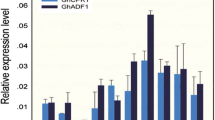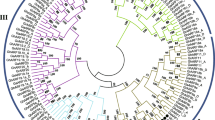Abstract
Cotton fiber is an ideal model for studying plant cell elongation and cell wall biogenesis, but the genes that are critical for the regulation of fiber development are largely unknown. We report here the cloning and characterization of a receptor-like kinase gene (designated GhRLK1), expression of which is induced during the period of active secondary wall synthesis in the cotton fiber cells. We demonstrate that GhRLK1 is located in the plasma membrane and shows dual specificity as both a serine/threonine kinase and a tyrosine kinase. Our results suggest a possible role of GhRLK1 in the signal transduction pathway that is involved in the induction and maintenance of active secondary wall formation during fiber development.






Similar content being viewed by others
References
Basra AS, Malik CP (1984) Development of cotton fiber. Int Rev Cytol 87:65–113
Becraft PW (2002) Receptor kinases signaling in plant development. Annu Rev Cell Dev Biol 18:163–192
Clark SE, Williams RW, Meyerowitz EM (1997) The CLAVATA1 gene encodes a putative receptor kinase that controls shoot and floral meristem size in Arabidopsis. Cell 89:575–585
Delmer DP (1999) Cellulose biosynthesis in developing cotton fibers. In: Basra AS (ed) Cotton fibers: developmental biology, quality improvement, and textile processing. Food Products Press, New York, pp85–112
Delmer DP, Pear JR, Andrawis A, Stalker DM (1995) Genes encoding small GTP-binding proteins analogous to mammalian rac are preferentially expressed in developing cotton fibers. Mol Gen Genet 248:43–51
Diévart A, Clark SE (2004) LRR-containing receptors regulating plant development and defense. Development 131:251–261
Hajdukiewicz P, Svab Z, Maliga P (1994) The small, versatile pPZP family of Agrobacterium binary vectors for plant transformation. Plant Mol Biol 25:989–994
Hecht V, Vielle-Calzada JP, Hartog MV, Schmidt EDL, Boutilier K, Grossniklaus U, de Vries SC (2001) The Arabidopsis somatic embryogenesis receptor kinase 1 gene is expressed in developing ovules and embryos and enhances embryogenic competence in culture. Plant Physiol 127:803–816
Jinn TL, Stone JM, Walker JC (2000) HAESA, an Arabidopsis leucine-rich repeat receptor kinase, controls floral organ abscission. Genes Dev 14:108–117
John M, Crow L (1992) Gene expression in cotton (Gossypium hirsutum L.) fiber: cloning of the mRNAs. Proc Natl Acad Sci USA 89:5769–5773
Kamps MP, Sefton BM (1989) Acid and base hydrolysis of phosphoproteins bound to immobilon facilitates analysis of phosphoamino acids in gel-fractioned proteins. Anal Biochem 176:22–27
Kim HJ, Barbara A, Triplett BA (2001) Cotton fiber growth in planta and in vitro. Models for plant cell elongation and cell wall biogenesis. Plant Physiol 127:1361–1366
Kobe B, Deisenhofer J (1994) The leucine-rich repeat: a versatile binding motif. Trends Biochem Sci 19:415–421
Li J, Chory J (1997) A putative leucine-rich repeat receptor kinase involved in brassinosteroid signal transduction. Cell 90:929–938
Li J, Wen J, Lease KA, Doke JT, Tax FE, Walker JC (2002) BAK1, an Arabidopsis LRR receptor-like protein kinase interacts with BRI1 and modulates brassinosteroid signaling. Cell 110:213–222
Li ZH, Wurtzel ET (1998) The ltk gene family encodes novel receptor-like kinases with temporal expression in developing maize endosperm. Plant Mol Biol 37:749–761
Meinert MC, Delmer DP (1977) Changes in biochemical composition of the cell wall of the cotton fiber during development. Plant Physiol 59:1088–1097
Morris ER, Walker JC (2003) Receptor-like protein kinases: the keys to response. Curr Opin Plant Biol 6:339–342
Mu JH, Lee HS, Kao TH (1994) Characterization of a pollen-expressed receptor-like kinase gene of Petunia inflata and the activity of its encoded kinase. Plant Cell 6:709–721
Nam KH, Li J (2002) BRI1/BAK1, a receptor kinase pair mediating brassinosteroid signalling. Cell 110:203–212
Nishiguchi M, Yoshida K, Sumizono T, Tazaki K (2002) A receptor-like protein kinase with a lectin-like domain from lombardy poplar: gene expression in response to wounding and characterization of phosphorylation. Mol Gen Genet 267:506–514
Pear JR, Kawagoe Y, Schreckengost WE, Delmer DP, Stalker DM (1996) Higher plants contain homologs of the bacterial celA genes encoding the catalytic subunit of cellulose synthase. Proc Natl Acad Sci USA 93:12637–12642
Rechateuber M (1990) PEST sequences are signals for rapid intracelluar proteolysis. Semin Cell Biol 1:433–440
Ruan YL, Llewellyn DJ, Furbank RT (2003) Suppression of sucrose synthase gene expression represses cotton fiber cell initiation, elongation, and seed development. Plant Cell 15:952–964
Scott A, Wyatt S, Tsou PL, Robertson D, Allen NS (1999) Model system for plant cell biology: GFP imaging in living onion epidermal cells. Biotechniques 26:1125–1132
Shah K, Vervoort J, de Vries SC (2001a) Role of threonines in the Arabidopsis thaliana somatic embryogenesis receptor kinase 1 activation loop in phosphorylation. J Biol Chem 276:41263–41269
Shah K, Gadella TWJ Jr, van Erp H, Hecht V, de Vries SC (2001b) Subcellular localization and oligomerization of the Arabidopsis thaliana somatic embryogenesis receptor kinase 1 protein. J Mol Biol 309:641—655
Shiu SH, Bleecker AB (2001) Receptor-like kinases from Arabidopsis form a monophyletic gene family related to animal receptor kinases. Proc Natl Acad Sci USA 98:10763–10768
Tanaka H, Watanabe M, Watanabe D, Tanake T, Machida C, Machida Y (2002) ACR4, a putative receptor kinase gene of Arabidopsis thaliana, that is expressed in the outer cell layers of embryos and plants, is involved in proper embryogenesis. Plant Cell Physiol 43:419–428
Tichtinsky G, Vanoosthuyse V, Cock JM, Gaude T (2003) Making inroads into plant receptor kinase signalling pathways. Trends Plant Sci 8:231–237
Torri KU (2004) Leucine-rich repeat receptor kinase in plants: structure, function, and signal transduction pathways. Int Rev Cytol 234:1–46
Torri KU , Mitsukawa N, Oosumi T, Matsuura Y, Yokoyama R, Whittier RF, Komeda Y (1996) The Arabidopsis ERECTA gene encodes a putative receptor protein kinase with extracellular leucine-rich repeats. Plant Cell 8:735–746
Trotochaud AE, Hao T, Wu G, Yang Z, Clark SE (1999) The CLAVATA1 receptor-like kinase requires CLAVATA3 for its assembly into a signaling complex that includes KAPP and a Rho-related protein. Plant Cell 11:393–406
Van der Geer P, Hunter T (1994) Phosphopeptide mapping and phosphoamino acid analysis by electrophoresis and chromatography on thin-layer cellulose plates. Electrophoresis 15:544–554
Wilkins TA, Jernstedt JA (1999) Molecular genetics of developing cotton fibers. In: Basra AS (ed) Cotton fibers: developmental biology, quality improvement, and textile processing. Food Products Press, New York, pp231–269
Zhao DZ, Wang GF, Speal B, Ma H (2002) The EXCESS MICROSPOROCYTES1 gene encodes a putative leucine-rich repeat receptor protein kinase that controls somatic and reproductive cell fates in the Arabidopsis anther. Genes Dev 16:2021–2031
Acknowledgments
This work was supported by the “863” High Technology Development Program (Grant No. 2004AA222090) and the National Special Program for Research and Industrialization of Transgenic Plants (Grant No. JY03-A-04-02). We thank Mr. Guang-Jun Dong for help with confocal microscopic analysis, and Prof. Lucien Caro for reading and polishing the manuscript.
Author information
Authors and Affiliations
Corresponding author
Additional information
Communicated by G. Jürgens
Rights and permissions
About this article
Cite this article
Li, YL., Sun, J. & Xia, GX. Cloning and characterization of a gene for an LRR receptor-like protein kinase associated with cotton fiber development. Mol Genet Genomics 273, 217–224 (2005). https://doi.org/10.1007/s00438-005-1115-z
Received:
Accepted:
Published:
Issue Date:
DOI: https://doi.org/10.1007/s00438-005-1115-z




